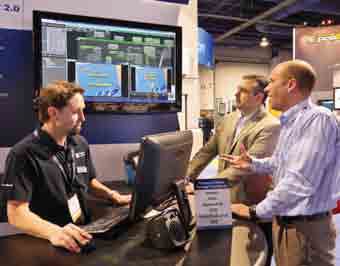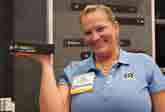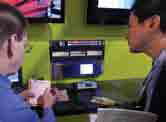Speed, compactness, and features defined signal processing technology at this year’s NAB Show. If backplanes get any denser, my fingers will be useless. From EAS to streaming, it’s all about efficiency, cost, reliability and space.
EAS/CAP
Joseph Forehand (C) with Turner and Scott Jex with LDS Church (C) receive a demo of Digital Rapids’ Transcode Manager 2.0 from Mike Rebel. Digital Alert Systems showed off their DASDEC- II Emergency Messaging Platform, a fully integrated system for emergency alert and CAP management. It includes automatic FCC-compliance logging with non-volatile memory, and a browser-based interface.

Gorman Redlich Mfg. Co. demo-ed their CAPDEC 1 CAP-to-EAS converter. It meets or exceeds all applicable specifications and helps broadcasters meet the CAP requirements using their current EAS equipment.
CLOSED CAPTIONING
AmberFin debuted new enterprise-class features for its iCR, including the integration of Softel’s Swift vTX which supports transcoding to a wide array of media formats while delivering the correctly formatted subtitle, caption and ancillary data.
EEG brought along their new1260 iCap Proxy which transforms any CC encoder into an iCap encoder. The company also showed the iCap Video real-time IP captioning system and their complete Streaming Caption Toolkit. Also on display was the HD490 digital closed captioning system, HD VANC encoding solution and the latest CCArchive application.
The professional video industry's #1 source for news, trends and product and tech information. Sign up below.
ENCO Systems presented enCaption3, their latest generation live automated captioning utility. Also showing were Embedded DAD, and DADv13.
Nexidia promoted Nexidia QC, an automated closed caption and video description application that ensures compliance, caption alignment, and language identification for broadcast and IP distribution. Also on display was Nexidia CC Director that repurposes on-air closed captioning for broadcast and IP distribution.
Softel, which was recently acquired by Miranda, introduced Swift, a family of rearchitected solutions for closed captioning/ subtitling and video description software to comply with IP video closed captioning rules. The company also debuted Media- Sphere, an interactivity platform for second screens.
Wohler has leveraged the technology from its RadiantGrid acquisition to introduce WohlerCaption which can handle the insertion of SCC or other aligned caption data files into the VANC or VBI space, or produce new ancillary outgoing files like SMPTE-TT or SAMI.
ENCODERS/DECODERS
ABE Elettronica Srl showed the EMX series of MPEG-2/4 SD/HD encoders with terrestrial, satellite, Webcasting and IP streaming applications. Features include SDI/HD-SDI inputs with embedded or AES-EBU audio, ASI/IP outputs, and an optional embedded modulator.
Adtec Digital demonstrated their EN-91P 1080p encoder, an ultra-low delay 1080p MPEG-4 AVC/H.264 HD device. When paired with Adtec’s RD-70 IRD, it delivers pictureto- picture services in 100 ms. Also in the booth was the RD-70 1080P receiver, a multi- CODEC with ultra-low, low and normal delay for MPEG-2 and MPEG-4 AVC/H.264 HD.
Ateme brought along their Kyrion CM5000 encoder, a modular contribution MPEG-2/4 unit that features high bit-rate support and a built-in video monitor. The company also showed the Kyrion DR5000 decoder. Both units featured dual power supplies and a front panel display user interface.
Digital Rapids demonstrated Transcode Manager 2.0 which is powered by Kayak for high-volume, file-based media processing. Also shown was the new StreamZ Live 8000EX integrated multiscreen and broadcast live encoder, along with the StreamZHD multiformat, live and file-based encoding system.
Comark Communications showcased their new CMX-5000 MPEG-2 DTV encoder/multiplexer, a low-cost, flexible and powerful system that supports a wide range of video formats and output configurations and incorporates a built-in multiplexer to deliver a 19.36 Mbps transport stream.
Elemental Technologies highlighted Elemental Live and Elemental Server performing 4K Ultra HD encoding, HEVC/H.265 encoding and UltraViolet content creation, with video streaming to a variety of end user players and devices. It also demo-ed encoding via Elemental Cloud; encoding features with Elemental Cloud mirror those available with Elemental Server and Elemental Live, ensuring the same high-quality video output is available from on-premise appliances and secure cloud-based transcoding resources.
Envivio spotlighted Envivio Muse Live, designed for 24/7 TV services via satellite, cable and IP networks. It compresses live SD or HD TV signals to any format and resolution, while maintaining video quality. Also displayed was Envivio Halo, which supports time-shifted TV applications.
Ericsson showed their SVP 5500 HEVC encoder, which reduces bandwidth requirements for video delivery by more than 50 percent, as compared to other H.264/MPEG- 4 AVC implementations. Also shown was the new AVP 4000, which is powered by Ericsson’s first-ever in-house-developed programmable video processing chip.
Haivision debuted its Makito X H.264 encoding platform with dual-channel HD encoding. It delivers twice the quality at half the bandwidth and features a 55 ms encoding latency, an extensive feature set, as well as the ability to deliver multiple bitrates from each source.
Harmonic showed its Ellipse 3000 contribution encoder that uses MPEG-2 and MPEG-4 AVC 4:2:0/4:2:2, 8- and10-bit compression technologies, and provides very low latency as well as multiformat and multicodec versatility.
Miranda Technologies offered a new frame sync input card for the Nvision 8500 series of hybrid routers, as well as the SME-1901 high-density streaming media encoder for the Densité modular line.
Media Excel showed its Hero encoding and transcoding product line, as well as its H.264/AVC encoding and decoding gear. The company demonstrated how its products will be upgradeable to its Intel-powered H.265 HEVC encoding technology.
PESA introduced its compact 1RU XStream which simultaneously encodes as many as five independent video streams and eight audio streams for multipath H.264 distribution.
Screen Service Broadcasting Technologies’ new ENC333A is an HD/SD/1SEG, MPEG- 2/H.264 encoder that provides real-time encoding of several HD and SD formats, maintains high quality video, and is suitable for broadcast transmission.
Thomson Video Networks Solutions showcased their ViBE EM series of MPEG-2/MPEG- 4 AVC encoders, the ViBE VS7000 video system, the new RD6000 contribution receiver decoder, and ViBE CP6000 contribution platform. Also shown was the ViBE EM4000 premium encoder that provides eight HD MPEG-4 AVC channels in a 1RU chassis.
Vitec showed their Optibase MGW Pico encoder, an ultra-small professional-grade device that provides full-featured HD/SD H.264 encoding and streaming with KLV metadata support. This pocket-sized encoder consumes less than 5 Watts and is offered with an enclosure or as board-only.
PROCESSING
Teena Rael with ESE serves up the new HD-491/SD, a time code decoder/LTC generator. Cobalt Digital brought along a new series of terminal gear cards, including the DCDA down-converter/distribution amplifier, and the DCDA-3G and DCDA-3G2 dual downconverters with 3G, frame sync-ing and AES outputs. Also shown was the Blue Box group of fiber units, as well as a range of throwdown modular brick units.

Crystal Vision Ltd. spotlighted their ViViD 3G variable video delays, along with the Synner 310, a video synchronizer, tracking audio delay and embedder/de-embedder for 3G, HD and SD. The company also showed the Tandem 0 combined embedder/de-embedder for 3G, HD and SD sources.
ESE arrived with the HD-455/SD/1, an SD/ HD timecode reader/video inserter, and the HD-491/SD, an SD/HD SDI timecode decoder/generator that accepts SDI signals. Also shown was the DV-228 1 x 8 SDI digital video distribution amplifier for 3G/ HD/SD.
Evertz introduced several new modular products, including frame synchronizers, audio embedders/de-embedders and a new conversion series, the 7814MMX, which provides 3G performance at HD prices, higher density module packaging, more control options and an enhanced feature set.
For-A demonstrated their FA-9520 full dualchannel multipurpose video processor and FA-1010 10-channel HD video processor/ frame sync. The company also demonstrated a range of IP encoders, including the IP-9610.
Gefen Pro AV Group showed off its 3G SDI audio embedder/de-embedder, along with its PRO 3G SDI scalers. Gefen also demonstrated its ToolBox Ultra HD splitters with 1:2, 1:4 and 1:8 distributions, and the DVI ELR (Extra Long Range) Lite, their new extender for DVI providing CAT-5 cable runs of up to 70 meters.
Harris demo-ed the Selenio networking module, which enables circuit-switched transport networks to transmit and receive video, audio and data between two Selenio frames. Also in the booth was the MDP6801+D metadata/data processing module and the X50 frame synchronizer/converter.
Lynx Technik launched a 3D support upgrade to the company’s SDI to HDMI converter, along with the new Yello GUI software application. Lynx also showed six new audio embedders/de-embedders and a new automatic control feature for the APPolo control system.
Ross Video spotlighted OpenGear Dash- Board v6 that enhances control over openGear, NK routers, and MC1 master control units, and includes new features such as Virtual Panels and PanelBuilder. Also shown were the Ross Nielsen Ratings encoders, which provide clients with an upgrade path for next generation technology.
Studio Technologies showed off its model 5152 video generator/audio embedder module which is designed to enhance broadcast applications. It allows four stereo digital audio signals to be embedded into an SDI signal and allows playback of custom HD video image files from a USB flash drive.
Triveni Digital introduced GuideBuilder 5, available in a variety of configurations, including integrated servers, software intended for use on customer-supplied servers, Virtual Machine (VM)-compatible software, and as a cloud-based managed service.
STANDARDS CONVERSION
Bluefish Technologies showed off its Epoch 4K Supernova conversion product that uses bi-directional BNC connectors and converts to/from SD, HD, 3G, ASI, AES and LTC.
Brightcove announced the general availability of the Zencoder Live Cloud Transcoding service, an open API for live video encoding in the cloud that allows content providers to instantly scale live encoding resources and produce adaptive bit-rate streams without significant investments in on-premise hardware.
Ensemble Designs was at the NAB Show with its new high-resolution support for its BrightEye Mitto high-performance scan converters. Computer video is converted to serial digital SD, HD and 3 Gbps on BNC electrical or fiber optic outputs. The new software supports 1920 x 1200 pixel images.
DekTek displayed its DTU-351 HD SDI input for USB-3 ports to simplify importing SDI signals into a computer.
David Wood (L) with Ensemble Designs draws a diagram to explain the BrightEye NXT 430
compact router to Taniguchi-san with Yomiuri Telecasting in Japan. Lawo North America brought along the V__ pro8 processor which does cross-format conversion, color correction, embedding and de-embedding.

Matrox brought their Convert DVI Plus, a cost-effective HD SDI scan converter that lets broadcasters incorporate content from computers, iPads and iPhones into news programs.
Roland Systems Group unveiled a new portable video converter line-up which includes the VC-1-HS (HDMI to SDI), VC-1-SH (SDI to HDMI), and the VC-1-DL (bidirectional SDI/HDMI with audio/video delay and frame syncing).
Snell showed KudosPro MC500, a low-cost signal processing platform with motioncompensated frame rate conversion and providing up/down/cross conversion from any broadcast standard to any other broadcast standard. Snell also showed their new IQ Modular range of format converters.
Wohler demonstrated their RadiantGrid New Media Automation Platform which handles transcoding, standards conversion, and audio processing, including loudness correction, quality control. The system also distributes media and integrates with traffic and rights management systems.
MULTIVIEWERS
Apantac launched the Tahoma Ultra 4K multiviewer, featuring four outputs to allow users to drive a single ultra hi-res monitor with 4K video (3840 x 2160 pixels). Also featured was the Tahoma IP series, which includes an integrated CATx system for sending signals to video and computer devices up to 115 feet away.
Cinegy brought along their Multiviewer 9.5, which monitors and analyzes AV IP streams and SDI signals locally and remotely.
Decimator Design featured their compact (handheld) DMON-10S 10-channel multiviewer with both SDI and HDMI outputs for 3G/HD/SD video, targeting field applications.
Ensemble Designs introduced the Avenue MV82 multiviewer, which handles eight sources and can be configured to display these on one or two screens. The Avenue MV164 accommodates 16 sources which may be displayed on as many as four separate screens.
Harris demonstrated the HView SX Pro Multiviewer, a compact, high-density signal processing and monitoring system.
Matrox spotlighted their MicroQuad, a fourchannel SDI-to-HDMI multiviewer for 3G/ HD/SD signals.
Miranda introduced Kaleido-MX and Kaleido- Modular-X multiviewers, available in configurations up to 64 x 4 and available in either 1RU or 3RU sizes.
TV One spotlighted the C3-540 Corio Master, which combines edge-blending, video wall processing, multiviewing, windowing, image warping, and video processing with up/down/cross-conversion in one device. TV One also showed its C2-6204 and C2- 6104A multiviewers.
Wohler showcased several multi-display products, including the RMQ Series quadsplit video monitors and the RMV16 multiviewer, which accepts analog composite, component, SD/HD-SDI and 3G signals, and provides outputs in VGA, DVI, and HDMI formats.
STREAMING/MOBILE/IPTV
Edward Wright (L) answers questions about Decimator Design’s DMON-4S quad (3G/HD/SD)-SDI to HDMI multiviewer and converter from Kevin Lewis with Arkansas Educational TV. Broadpeak unveiled their umbrellaCDN, which allows content providers to allocate the ideal content delivery network for their material. They also demonstrated C-CAS technology (Conditional Access System- Compliant Adaptive Streaming), which enables pay-TV operators to support adaptive streaming protocols.

DVEO division of Computer Modules, Inc. displayed the MPEG Magnus , a 40 stream, IP to IP, MPEG-2-to-H.264 HD/SD transcoder. It provides real-time broadcast quality SD or HD (up to 1080p), serving as an IP-to- IP, MPEG-2-to-H.264 transcoder, scaler, and streamer.
Fujitsu’s IP encoders now feature a new firmware release that improves end-to-end latency. Models shown included the IP- 9610, IP-900, and IP-920.
Globecomm announced new end-to-end IP platforms and MPEG-2/4 conversion.
Media Links Inc launched the MD8400 video transmission platform, a modular, multimedia IP-based transport system designed to interoperate seamlessly with legacy MD8000 core networks and delivers Ethernet data traffic, SD/HD/3G and DVB-ASI video signals natively or with JPEG 2000 and H.264 compression.
Miranda launched its SME-1901 streaming media encoder module, which features a core router and fan-in/fan-out distribution amplification and monitoring. It provides H.264 video and AAC audio encoding for up to 20 streams per frame.
Nevion displayed their Flashlink live media networking system which provides 10 Gbps uncompressed video transport, Ethernet, data and communications over IP, asynchronous transport of multiplexed audio, and digital sync distribution with zero latency. Nevion also showed VideoIPath, an end-to-end managed media solution.
Sencore showcased their TXS 8600 transcoder, which offers high-density, multiprofile encoding and transcoding for realtime adaptive bit rate video-streaming.
Telestream announced the new Vantage Cable/IPTV transcoder, which automates content preparation and delivery for cable VOD and IPTV workflows. It offers full 16-bit video processing and the use of the x264 (H.264) codec.
Thomson Video Networks has included streaming technology from Zixi in Thomson’s ViBE CP6000 contribution platform. The integration was demonstrated with an HD MPEG-4 4:2:0 8-bit signal sent from a ViBE CP6000 in France via Zixi Broadcaster Cloud services to Singapore. There a Zixi Broadcaster picked up the stream and retransmitted it to the two companies’ booths.
VidOvation unleashed their VidO-Stream Webcasting and video streaming technology, a self-contained portable streaming video encoder that delivers an HD stream with up to 1920 x 1080 resolution and operates at up to 10 Mbps in a small footprint. The company also showed their IPTV and VoIP systems.
